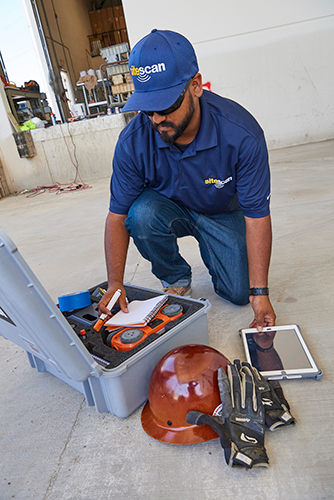Key Advantages of Utilizing Concrete Scanning Modern Technology
Key Advantages of Utilizing Concrete Scanning Modern Technology
Blog Article
Reveal the Transformative Power of Concrete Scanning in Taking Full Advantage Of Performance and Safety And Security
Concrete scanning has emerged as a crucial device in the building and construction market, supplying unrivaled advantages in enhancing project performance and making sure safety requirements. The transformative power of concrete scanning exists in its ability to supply detailed understandings and real-time data, reinventing just how jobs are planned and executed.
Value of Concrete Scanning
Guaranteeing the structural integrity and safety and security of construction projects begins with the critical step of carrying out comprehensive concrete scanning. Concrete scanning is a non-destructive approach used to discover and map subsurface components within concrete frameworks. This procedure is crucial in determining possible risks, such as rebar, post-tension cables, and conduits, that may be hidden within the concrete. By utilizing innovative modern technologies like ground-penetrating radar (GPR) and electromagnetic induction, building teams can accurately situate these components without causing any damage to the structure.
Furthermore, concrete scanning helps in optimizing job timelines and budget plan by staying clear of unanticipated expenses and hold-ups that may develop due to unforeseen obstructions within the concrete. Eventually, investing in extensive concrete scanning is a positive technique that boosts both effectiveness and safety and security in building jobs.
How Concrete Scanning Functions
Concrete scanning operates as a critical tool in construction tasks by utilizing sophisticated technologies to spot and map subsurface components without triggering architectural damages. Ground Penetrating Radar (GPR) and Electromagnetic Induction (EMI) are two primary approaches made use of in concrete scanning.
During the scanning procedure, the data collected is analyzed in real-time, enabling immediate identification of prospective dangers or barriers under the surface area. By employing these advanced innovations, concrete scanning significantly decreases the danger of expensive problems and injuries on construction sites.
Advantages of Concrete Scanning
Using advanced scanning modern technologies in building tasks provides a multitude of advantages, improving both efficiency and safety on-site. One of the primary benefits of concrete scanning is the ability to discover and find ingrained items such as rebar, post-tension cable televisions, and conduits accurately. By identifying these elements prior to exploration or cutting into concrete structures, the danger of unexpected strikes is considerably decreased, protecting against possible injuries to employees and damage to the framework itself. Additionally, concrete scanning assists in planning and designing better, as it provides specific info about the area and deepness of structural parts.

Study: Concrete Scanning Success

In another case, a construction company made use of 3D concrete scanning to analyze the problem of maturing concrete structures in a historical building. The in-depth scans supplied click over here now useful understandings right into the level of wear and tear and helped focus on upkeep initiatives efficiently. By proactively resolving locations of issue determined through scanning, the business was able to expand the lifespan of the structure and make sure resident security.
These instance studies highlight the transformative power of concrete scanning in boosting effectiveness, accuracy, and security in building and construction projects.
Implementing Concrete Scanning in Projects
Carrying out advanced scanning modern technologies throughout building and construction tasks has actually become progressively necessary for enhancing precision and safety and security. By integrating concrete scanning right into task preparation and execution, building and construction groups can recognize possible dangers, such as rebar or post-tension cords, hidden within concrete frameworks. This aggressive strategy decreases the danger of accidents, delays, and expensive rework, inevitably causing a lot more efficient job timelines and budget plans.
To implement concrete scanning properly, task supervisors should collaborate carefully with experienced scanning experts to determine one of the most ideal scanning this techniques for the certain project requirements. Engaging scanning experts from the early phases of a project enables the group to produce detailed scanning plans that attend to vital areas of worry and make sure extensive data collection.
Moreover, including concrete scanning into routine task operations can simplify decision-making procedures, as real-time scan information gives immediate understandings right into the problem of concrete structures - Concrete Scanning. This data-driven strategy facilitates informed analytical and allows groups to make changes quickly, cultivating a society of efficiency and safety throughout the job lifecycle
Final Thought
Finally, concrete scanning plays a critical role in improving effectiveness and safety in building and construction tasks. By making use of innovative technology to map and identify out underlying frameworks within concrete, this procedure assists to stop pricey errors, make certain architectural integrity, and reduce risks on website. With the capacity to discover covert elements and supply accurate information, concrete scanning verifies to be a valuable tool for maximizing job results and optimizing overall success.
Concrete scanning is a non-destructive approach utilized to identify and map subsurface aspects within concrete structures. In addition, concrete scanning aids in enhancing job timelines and spending plan by staying clear of unanticipated expenses and delays that might occur due to unforeseen obstructions within the concrete. One notable instance research study entails a large-scale improvement job where concrete scanning played a vital function in guaranteeing project success.In one more instance, a construction firm used 3D concrete scanning why not try here to evaluate the condition of aging concrete frameworks in a historic structure. By incorporating concrete scanning into project planning and implementation, building teams can determine possible threats, such as rebar or post-tension wires, hidden within concrete structures.
Report this page